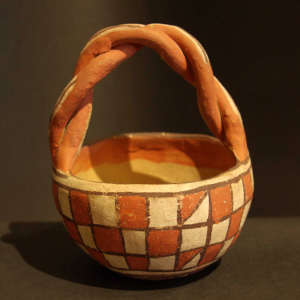Isleta Pueblo
- TUE-I: Town
- Language: Southern Tiwa
- Size: 211,000 Acres
- Population: Ca. 4,800
The Pueblo of Isleta is in the center of the Rio Grande Valley about 13 miles south of Albuquerque. The pueblo is comprised of the main village of Isleta and two small villages, Oraibi and Chicale. The name Isleta means Little Island in Spanish. Isleta has long been connected to the pueblo of Sandia, about 14 miles north of Albuquerque on the other side of the Rio Grande. Both pueblos speak Southern Tiwa but Sandia has not been known for its pottery.
While the original site of Isleta Pueblo can't be dated earlier than about 1500 CE, there is archaeological evidence that many villages were established in the area during the 1300s (about the time of the abandonment of most villages and pueblos in the Four Corners area because of long-term drought). The Isleta people did not participate in the 1680 Pueblo Revolt and many fled south with the Spanish when they retreated to the El Paso area. Some say the Spanish forced the Isleta people to join them while others say they joined voluntarily.
After the Spanish were gone, those Isletans who had managed to evade the Spanish and remain in the area re-occupied the village when it was safe. The Spaniards did return in 1681 and they attacked Isleta, capturing more than five hundred people. Those Isletans who escaped that attack fled the area and settled near the Hopi in Arizona. There they (and Tiwas from Alameda Pueblo) built the pueblo at Payupki.
Most of the Isletans who had gone south with the Spanish in 1680 chose not to return in 1692 (when the Spanish returned to northern New Mexico in force). Instead, they established the village of Ysleta del Sur near El Paso, Texas and they still live there today. In the 1700s some Isletans returned to the area of their original pueblo and were joined by refugees from other pueblos over the following years.
The Isleta mission was dedicated to San Antonio when it was built in 1613. The church was partially destroyed during the Pueblo Revolt and was rebuilt in 1716. Today the mission is named San Augustine Catholic Church and it is still the pueblo parish church.
In 1880 a traditionalist group displaced from Laguna Pueblo were given some land to live on by the Isletans and eventually, some of the newcomers intermarried and were absorbed into the general Isleta population. Others of that group returned to Laguna around 1890 and established the village of Mesita. However, those folks from Laguna had brought certain of their kachinas with them, kachinas that were not previously present at Isleta. When most of those from Laguna went back to Laguna, they could not take one of the kachinas back. They had previously promised Isleta that kachina would remain at Isleta in return for the land they had been given. Even today, there's a Laguna ritual specialist living at Isleta to care for and protect that kachina's mask.
The pieces below were made by Laguna potters living at Isleta, made for the tourist trade
Pottery History
Before the arrival of the immigrants from Laguna, Isleta potters had long made a plain redware. From the Laguna immigrants Isleta potters learned polychrome methods and today, generally produce polychromes based on the Laguna style. They did modify the Laguna brown, black and tan method by adding white elements to the paints, giving the colors and designs a softer tone.
Today Isleta pottery is known most for the storyteller figures made by Stella Teller and her descendants. Caroline Carpio, the Jojolas family and Diane Wade are also noted Isleta potters who produce traditional Isleta pottery. Isleta is also home to Kimo Decora, a potter of Winnebago and Isleta heritage.
When the Archaeology Department of the University of New Mexico finally let go of the piece of land that includes the prehistoric settlement at Pottery Mound, they transferred the title to Isleta.







